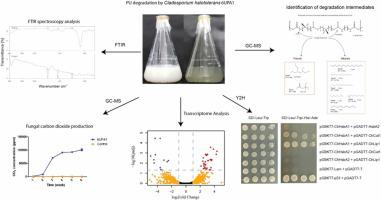Journal of Hazardous Materials ( IF 12.2 ) Pub Date : 2022-06-18 , DOI: 10.1016/j.jhazmat.2022.129406 Kai Zhang 1 , Jiege Hu 1 , Shuai Yang 1 , Wei Xu 1 , Zhichao Wang 1 , Peiwen Zhuang 1 , Hans-Peter Grossart 2 , Zhuhua Luo 3

|
Lack of degradability and the accumulation of polymeric wastes increase the risk for the health of the environment. Recently, recycling of polymeric waste materials becomes increasingly important as raw materials for polymer synthesis are in short supply due to the rise in price and supply chain disruptions. As an important polymer, polyurethane (PU) is widely used in modern life, therefore, PU biodegradation is desirable to avoid its accumulation in the environment. In this study, we isolated a fungal strain Cladosporium halotolerans from the deep sea which can grow in mineral medium with a polyester PU (Impranil DLN) as a sole carbon source. Further, we demonstrate that it can degrade up to 80% of Impranil PU after 3 days of incubation at 28 ℃ by breaking the carbonyl groups (1732 cm-1) and C-N-H bonds (1532 cm-1 and 1247 cm-1) as confirmed by Fourier-transform infrared (FTIR) spectroscopy analysis. Gas chromatography-mass spectrometry (GC-MS) analysis revealed polyols and alkanes as PU degradation intermediates, indicating the hydrolysis of ester and urethane bonds. Esterase and urease activities were detected in 7 days-old cultures with PU as a carbon source. Transcriptome analysis showed a number of extracellular protein genes coding for enzymes such as cutinase, lipase, peroxidase and hydrophobic surface binding proteins A (HsbA) were expressed when cultivated on Impranil PU. The yeast two-hybrid assay revealed that the hydrophobic surface binding protein ChHsbA1 directly interacts with inducible esterases, ChLip1 (lipase) and ChCut1 (cutinase). Further, the KEGG pathway for “fatty acid degradation” was significantly enriched in Impranil PU inducible genes, indicating that the fungus may use the degradation intermediates to generate energy via this pathway. Taken together, our data indicates secretion of both esterase and hydrophobic surface binding proteins by C. halotolerans plays an important role in Impranil PU absorption and subsequent degradation. Our study provides a mechanistic insight into Impranil PU biodegradation by deep sea fungi and provides the basis for future development of biotechnological PU recycling.
中文翻译:

海洋真菌Cladosporium halotolerans 6UPA1对聚酯聚氨酯的生物降解
缺乏可降解性和聚合废物的积累增加了对环境健康的风险。最近,聚合物废料的回收变得越来越重要,因为聚合物合成的原材料由于价格上涨和供应链中断而供不应求。聚氨酯(PU)作为一种重要的聚合物,在现代生活中得到了广泛的应用,因此,PU的生物降解是避免其在环境中的积累是可取的。在这项研究中,我们从深海中分离出一种真菌菌株Cladosporium halotolerans,它可以在以聚酯 PU (Impranil DLN) 作为唯一碳源的矿物培养基中生长。此外,我们证明它可以通过破坏羰基(1732 cm -1) 和 CNH 键 (1532 cm -1和 1247 cm -1) 经傅里叶变换红外 (FTIR) 光谱分析证实。气相色谱-质谱 (GC-MS) 分析显示多元醇和烷烃作为 PU 降解中间体,表明酯键和氨基甲酸酯键发生水解。在以 PU 作为碳源的 7 天龄培养物中检测到酯酶和脲酶活性。转录组分析显示,在 Impranil PU 上培养时,表达了许多编码酶如角质酶、脂肪酶、过氧化物酶和疏水表面结合蛋白 A (HsbA) 的细胞外蛋白基因。酵母双杂交试验显示疏水表面结合蛋白 ChHsbA1 直接与诱导型酯酶 ChLip1(脂肪酶)和 ChCut1(角质酶)相互作用。此外,“脂肪酸降解”的 KEGG 途径显着富集 Impranil PU 诱导基因,表明真菌可以使用降解中间体通过该途径产生能量。总之,我们的数据表明酯酶和疏水表面结合蛋白的分泌是通过C. halotolerans在 Impranil PU 吸收和随后的降解中起重要作用。我们的研究为深海真菌对 Impranil PU 的生物降解提供了机理见解,并为未来发展生物技术 PU 回收利用提供了基础。











































 京公网安备 11010802027423号
京公网安备 11010802027423号